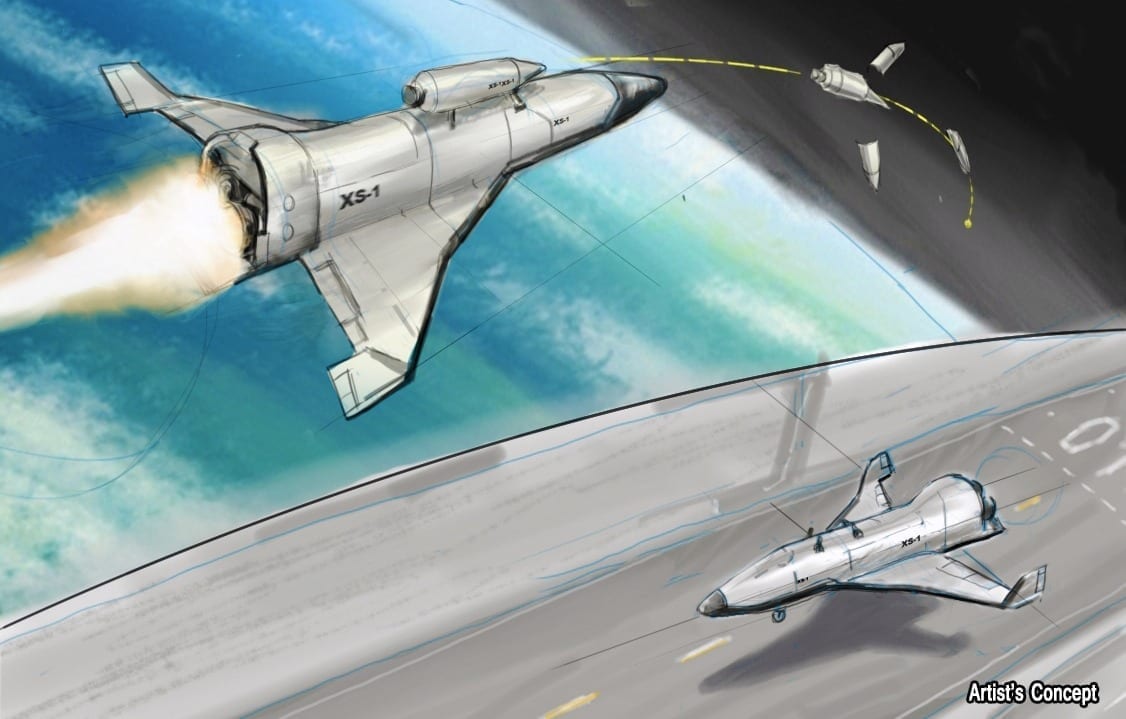
New program seeks to lower satellite launch costs by developing a reusable hypersonic unmanned vehicle with costs, operation and reliability similar to traditional aircraft
Commercial, civilian and military satellites provide crucial real-time information essential to providing strategic national security advantages to the United States. The current generation of satellite launch vehicles, however, is expensive to operate, often costing hundreds of millions of dollars per flight. Moreover, U.S. launch vehicles fly only a few times each year and normally require scheduling years in advance, making it extremely difficult to deploy satellites without lengthy pre-planning. Quick, affordable and routine access to space is increasingly critical for U.S. Defense Department operations.
To help address these challenges, DARPA has established the Experimental Spaceplane (XS-1) program. The program aims to develop a fully reusable unmanned vehicle that would provide aircraft-like access to space. The vehicle is envisioned to operate from a “clean pad” with a small ground crew and no need for expensive specialized infrastructure. This setup would enable routine daily operations and flights from a wide range of locations. XS-1 seeks to deploy small satellites faster and more affordably, while demonstrating technology for next-generation space and hypersonic flight for both government and commercial users.
“We want to build off of proven technologies to create a reliable, cost-effective space delivery system with one-day turnaround,” said Jess Sponable, DARPA program manager heading XS-1. “How it’s configured, how it gets up and how it gets back are pretty much all on the table—we’re looking for the most creative yet practical solutions possible.”
DARPA seeks ideas and technical proposals for how to best develop and implement the XS-1 program. The agency has scheduled an XS-1 Proposers’ Day for Monday, October 7, 2013. The agency also plans to hold 1-on-1 discussions with potential proposers on the following day, October 8, 2013. Advance registration is required; more information is available at http://www.sa-meetings.com/XS1ProposersDay. Registration closes on Tuesday, October 1,2013, at 12:00 PM EDT. For more information, please email [email protected].
The DARPA Special Notice describing the specific capabilities the program seeks is available at http://go.usa.gov/DNkF. A Broad Agency Announcement (BAA) for XS-1 is forthcoming and will be posted on the Federal Business Opportunities website.
XS-1 envisions that a reusable first stage would fly to hypersonic speeds at a suborbital altitude. At that point, one or more expendable upper stages would separate and deploy a satellite into Low Earth Orbit. The reusable hypersonic aircraft would then return to earth, land and be prepared for the next flight. Modular components, durable thermal protection systems and automatic launch, flight, and recovery systems should significantly reduce logistical needs, enabling rapid turnaround between flights.
Key XS-1 technical goals include flying 10 times in 10 days, achieving speeds of Mach 10+ at least once and launching a representative payload to orbit. The program also seeks to reduce the cost of access to space for small (3,000- to 5,000-pound) payloads by at least a factor of 10, to less than $5 million per flight.
The Latest Bing News on:
Spaceplane
- Dream Chaser spaceplane completes tests at NASA’s Neil Armstrong facilityon May 9, 2024 at 1:29 pm
Commercial spaceplanes traveling to the International Space Station (ISS) are a step closer to reality. Sierra Space’s Dream Chaser spaceplane, called Tenacity, completed its pre-flight testing at ...
- Dream Chaser Set For Move To NASA Kennedy Space Centeron May 9, 2024 at 3:08 am
Sierra Space’s Dream Chaser lifting body spaceplane "Tenacity" and its Shooting Star cargo module are being readied for shipment to NASA’s Kennedy Space Center (KSC) in Florida for final testing and ...
- Sierra Space Reinvents Space Transportation with Dream Chaser®on May 9, 2024 at 1:00 am
announced today the successful completion of a rigorous environmental test suite on the revolutionary Dream Chaser® spaceplane, Tenacity®, at NASA’s Neil Armstrong Test Facility in Sandusky, Ohio. As ...
- Sierra Space prepares to ship Dream Chaser to Floridaon May 8, 2024 at 5:00 pm
Credit: Sierra Space WASHINGTON — Sierra Space says it has wrapped up a series of environmental tests of its Dream Chaser cargo spaceplane at a NASA facility in Ohio and is ready to ship the ...
- Virgin Galactic plans higher mothership flight rate with next-generation spaceplaneson May 8, 2024 at 4:43 pm
Virgin Galactic says it will fly its existing “mothership” aircraft more frequently than previously planned with its upcoming Delta-class spaceplanes.
- Why Virgin Galactic Stock Just Dropped an Unlucky 7%on May 8, 2024 at 9:21 am
Last night, space tourism pioneer Virgin Galactic (NYSE: SPCE) announced its earnings from the first quarter with the only spaceplane it has. The news was not great, and as of 11:05 a.m. ET on ...
- Highlights Of Dawn Aerospace's Suborbital Space Plane's First Rocket Powered Flighton May 7, 2024 at 5:00 pm
Watch the Dawn Aerospace's Mk-II Aurora Spaceplane light up it rocket engine test flight. Credit: Dawn Aerospace 12 Things Your Partner Should Never Say to You—or Vice Versa Cheese Recall Map Shows ...
- Mortgage business laying off dozens in the south Denver metro areaon May 7, 2024 at 1:51 pm
A national mortgage loan originator business is laying off dozens of employees this summer in Greenwood Village after a recent acquisition by its parent company. Newrez LLC is permanently letting go ...
- China Briefly Had Two Secretive Spaceplanes In Flight, And One Is Still Unaccounted Foron August 28, 2022 at 2:16 pm
The state-owned China Aerospace Science and Technology Corporation (CASC) reported late Thursday that the contractor for the Chinese space program has successfully reused a suborbital spaceplane f ...
- X-37B Spaceplane To Test Power Beaming Technologyon May 28, 2020 at 12:21 am
The spaceplane still needs to hitch a ride to space on a commercial rocket like the Atlas V or the Falcon 9, but once it’s separated from the booster, the remainder of the X-37B’s mission is a ...
The Latest Google Headlines on:
Spaceplane
[google_news title=”” keyword=”Spaceplane” num_posts=”10″ blurb_length=”0″ show_thumb=”left”]
The Latest Bing News on:
Reusable hypersonic vehicle
- Leveraging Public-Private Partnership to Meet the Hypersonic Challengeon April 28, 2024 at 5:00 pm
First, this reusable hypersonic platform offers key tools to technology developers of future weapons and other vehicles. Second, it stands to enhance our own defenses against such weapons. The first ...
- Black Mystery Craft Spotted Slung Under Chinese H-6 Bomberon April 22, 2024 at 5:39 pm
What is seen hanging underneath an H-6 in a recent picture is not a WZ-8 rocket drone, leaving open multiple possibilities.
- Modified Chinese H-6 Bomber Spotted Carrying Mysterious Droneon April 21, 2024 at 5:00 pm
The bomber is possibly carrying the WZ-8 high altitude supersonic reconnaissance drone or the MD-22 reusable hypersonic drone. A low-res photo, possibly taken by a cell phone, has surfaced online ...
- Hypersonic Technology Market Top Players, Revenue, Share, Future Trends, Size, Report and Forecast 2024 to 2032on April 17, 2024 at 5:02 am
With the potential to drastically reduce travel times across continents and even enable access to space with reusable hypersonic vehicles, the commercialization of hypersonic technology holds the ...
- Pentagon Slows And Adapts Long-Range Hypersonic Defense Planon April 15, 2024 at 5:00 pm
The threat posed by offensive hypersonic glide vehicles (HGV) materialized less than five years ago. Russia’s Avangard and China’s DF-17 and -27 missile systems are now operational ...
- Supersonic and Hypersonic Technologies Departmenton April 11, 2024 at 9:54 am
Technologically oriented research for industrial developments of supersonic and hypersonic flight vehicles In the Supersonic and Hypersonic ... plays a very important role in the development of ...
- DARPA Eyes Hypersonic Striker As Air Force Studies Long-Term Optionson April 7, 2024 at 5:00 pm
DARPA has started soliciting industry to prove out essential technology components for a reusable hypersonic bomber prototype that could enter the design phase within five years. Much about the ...
- Stratolaunch’s air-launched test vehicle goes supersonic in its first powered flighton March 11, 2024 at 12:10 am
Stratolaunch’s single-use TA-1 test vehicle blazed a trail for future reusable hypersonic test vehicles that are expected to help the U.S. military catch up on one of the frontiers of aerial combat.
- Sky’s the limit for high-speed test caseon April 7, 2022 at 8:53 pm
“The closest we’ve got to truly reusable hypersonic vehicles are probably the Falcon 9 rockets from SpaceX. Those are briefly hypersonic and they are rapidly reusable. They’re at the point ...
- US planning global-reach missiles: allies not requiredon August 3, 2016 at 8:52 pm
The ultimate goal would be a "reusable hypersonic cruise vehicle (HCV) . . . capable of taking off from a conventional military runway and striking targets 9,000 nautical miles distant in less ...
The Latest Google Headlines on:
Reusable hypersonic vehicle
[google_news title=”” keyword=”reusable hypersonic vehicle” num_posts=”10″ blurb_length=”0″ show_thumb=”left”]










